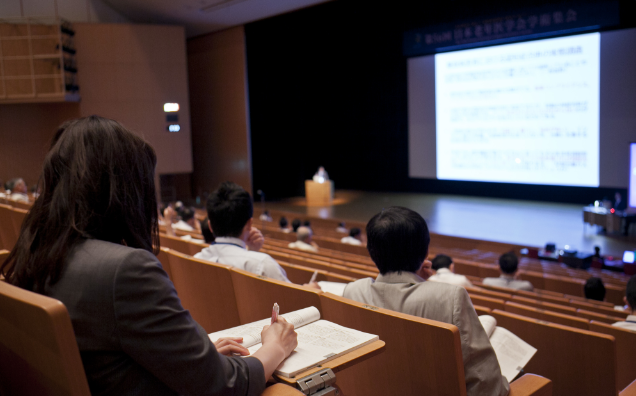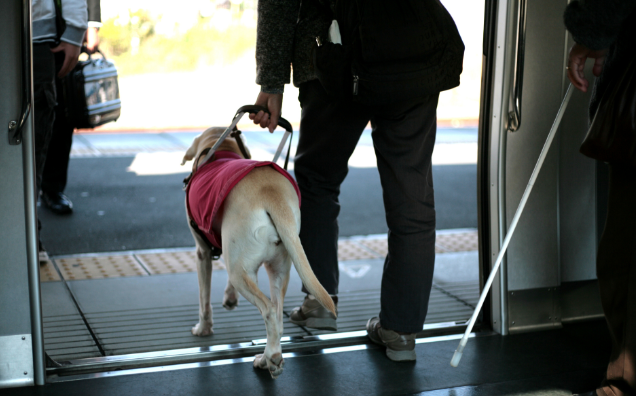- TOP >
- Efforts of Minshuku Noboryusou
Efforts of Minshuku Noboryusou 1064-1 Mitsune, Hachijo-machi, Hachijojima, Tokyo
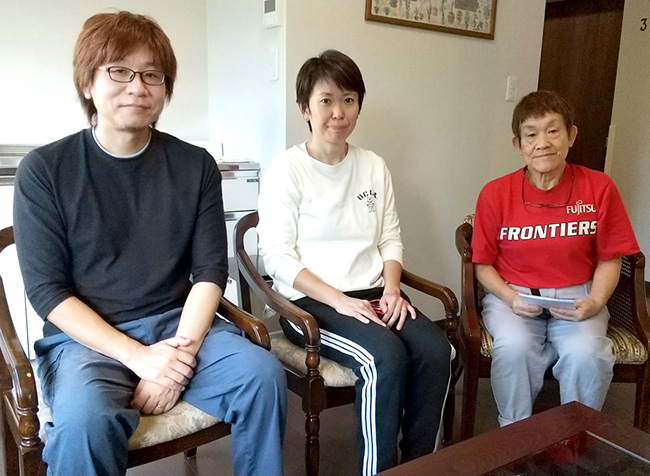 From left to right: Yoshikazu, Mina, and Kaoru Kida
From left to right: Yoshikazu, Mina, and Kaoru Kida
A completely barrier-free minshuku
Noboryusou is a minshuku (family-run, guesthouse-style lodging) on Hachijojima Island, located about an hour by air from Haneda Airport. In January 2023, the minshuku reopened as a completely barrier-free accommodation facility, utilizing the Subsidy to Promote Barrier-Free Accommodations from the Tokyo Metropolitan Government. Owner Yoshikazu Kida and family members Mina Kida and Kaoru Kida spoke with us about their barrier-free efforts to date.
 From left to right: Yoshikazu, Mina, and Kaoru Kida
From left to right: Yoshikazu, Mina, and Kaoru Kida
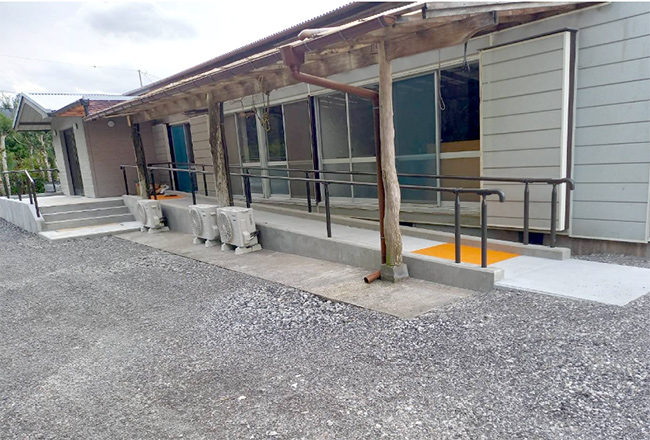 Stairs and ramp at the entrance to Noboryusou
Stairs and ramp at the entrance to Noboryusou
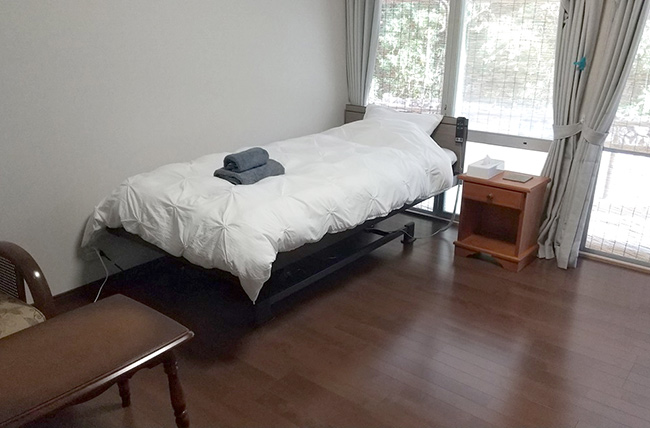 Single Room
Single Room
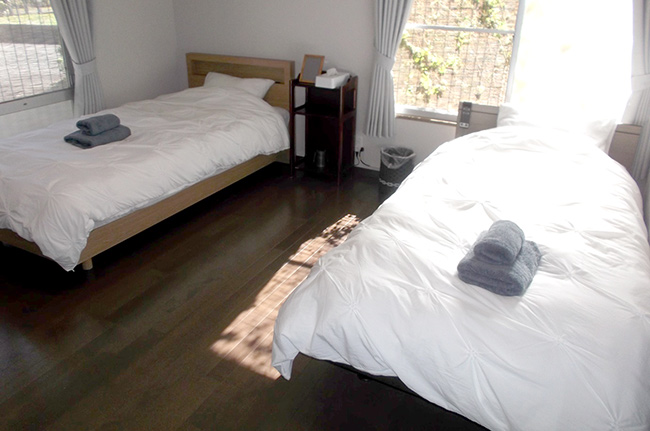 Twin Room
Twin Room
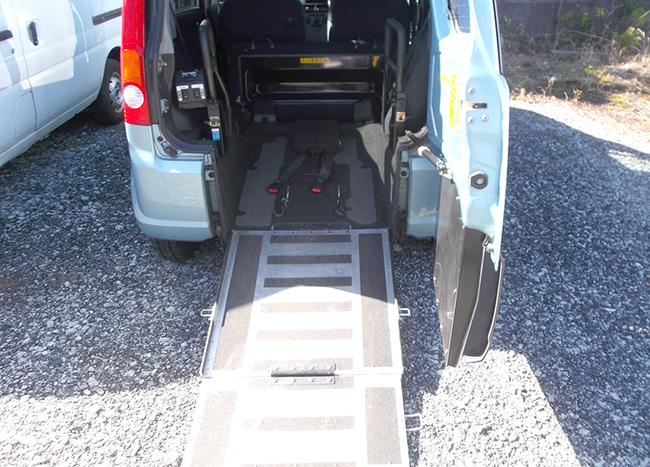 Wheelchair-accessible transport vehicle
Wheelchair-accessible transport vehicle
We converted the entire minshuku into a barrier-free facility, believing that “the future is barrier-free!”
In the fall of 2019 when we were beginning to consider renovating our aging facility, we attended a seminar promoting barrier-free accommodations, organized by the Tokyo Metropolitan Government and held on Hachijojima Island. This seminar got us thinking about whether we could use the Tokyo Metropolitan Government’s subsidy for our renovation project. Driven by the idea that “barrier-free accommodation facilities will be valued in the future” and that “now is the time for barrier-free and universal design,” we began considering the possibility of making our entire building completely barrier-free. Although there were many twists and turns along the way, not least the COVID-19 pandemic that followed shortly thereafter, we persevered and stayed with the plan while receiving suggestions and advice from an Advisor on Barrier-Free Lodging Facilities of Tokyo. The renovation project took three years, but at the end of it, a new Noboryusou was born with a gently sloping ramp at the entrance and step-free accessibility to every room.
We furnished all six rooms (two single rooms and four twin rooms) with electric adjustable beds, creating a safe and secure space throughout the building in compliance with the Tokyo Metropolitan Government’s design standards. In addition, we acquired a wheelchair-accessible vehicle to transport guests to and from the airport (or elsewhere) upon request. Having removed all steps from the building, guests who use wheelchairs and elderly people with weak legs and backs can fully enjoy their stay on Hachijojima Island in comfort.
Since reopening, guests with disabilities have told us that our minshuku enabled them to stay on the island, that it was very comfortable, and that they would come back again. Their warm words made us feel so glad that we had taken the plunge to renovate the facility.
Initially, we thought that simply renovating the minshuku as much we could (remodeling level) would be sufficient, but that would mean repeatedly remodeling the facility as needs arose, and worrying about it each time while remaining in operation. Instead, this program has allowed us to fulfill our family’s desire to create a fully barrier-free accommodation facility that meets the needs of the coming era.
It took more than three years to reopen due to factors such as the pandemic and uncertainties about the state of the world. During that time, the renovation project did not always go as planned. We faced soaring prices and non-delivery of construction materials. There were many details in terms of achieving a completely barrier-free design that we did not know how to handle, so we consulted with an architect and our advisor from the Tokyo Metropolitan Government. Before opening, we had an acquaintance who uses a wheelchair due to a spinal cord injury and paraplegia check the usability of the rooms and communal areas. It was only then that we learned that there were no wheelchair-accessible taxis on the island, which prompted us to procure the aforementioned wheelchair-accessible transport vehicle. We thought that it would be meaningless to renovate the minshuku into a barrier-free facility if wheelchair users could not even get here when they came to the island.
 Stairs and ramp at the entrance to Noboryusou
Stairs and ramp at the entrance to Noboryusou
 Single Room
Single Room
 Twin Room
Twin Room
 Wheelchair-accessible transport vehicle
Wheelchair-accessible transport vehicle
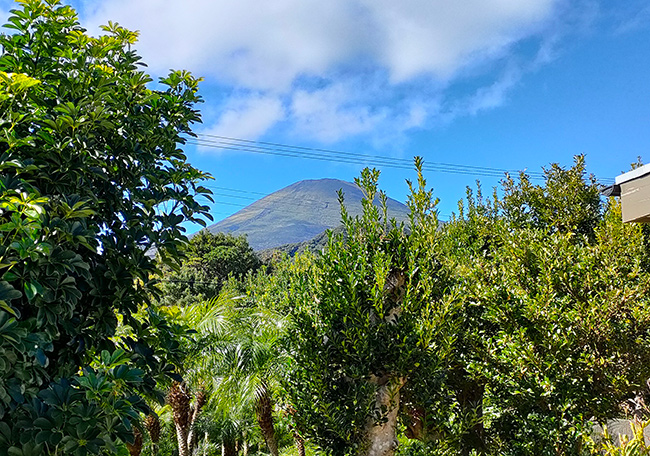 Pygmy date palms and Mt. Hachijo-Fuji seen from the window
Pygmy date palms and Mt. Hachijo-Fuji seen from the window
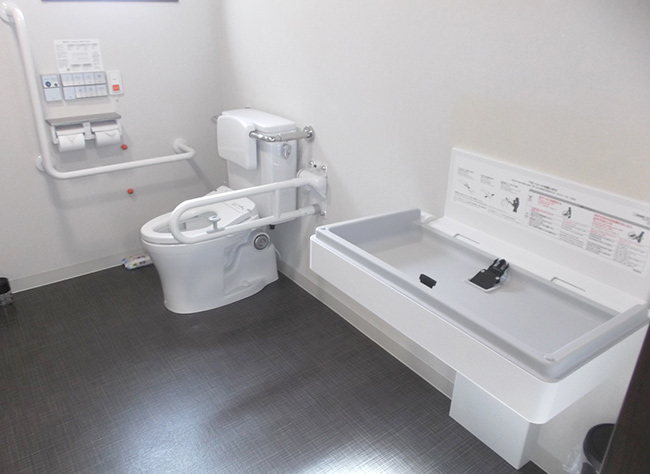 Toilet rooms with plenty of space
Toilet rooms with plenty of space
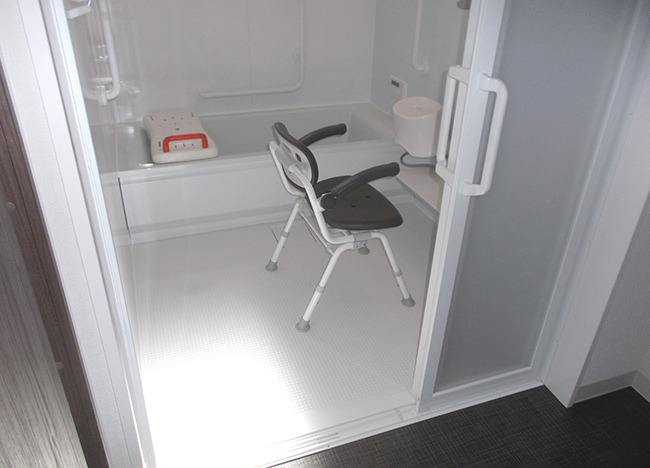 Shared bath with a step-free entrance
Shared bath with a step-free entrance
The best thing about going barrier-free
We are glad that wheelchair users will be able to stay at our minshuku without having to worry about access from the airport or how they will get around in the building. I still remember how one man who used a wheelchair and was paralyzed from the waist down due to cerebral infarction wanted to give his wife a memorable trip to Hachijojima Island for her birthday, but had struggled to find accommodations that were accessible to wheelchair users. So when the couple checked out from our minshuku and said, “Thanks to Noboryusou, I was able to give my wife a fantastic present,” and that “it was an amazing memory,” I felt a surge of emotion in my chest that instantly blew away all the hardships we had gone through.
Since renovating, some unexpected things have happened—in a good way. When we first opened, we envisioned that our core demographic would be the aging tourist population. However, since opening, our minshuku has also been used by foreign visitors to Japan (so far, we have had international visitors from Northern Europe, France, Germany, Italy, China, Singapore, and Malaysia). European guests in particular appreciate the tropical view of the pygmy date palms (called ro-be on the island) from the windows.
Everyone is delighted when they enter their room and exclaim, “It’s so spacious!” We made sure that each room has plenty of space, with no unnecessary obstacles that would prevent wheelchair users from moving around easily inside the room. We realized that going barrier-free is something that makes everyone happy, and we feel confident in our ability to invite any and all visitors to stay here.
 Pygmy date palms and Mt. Hachijo-Fuji seen from the window
Pygmy date palms and Mt. Hachijo-Fuji seen from the window
 Toilet rooms with plenty of space
Toilet rooms with plenty of space
 Shared bath with a step-free entrance
Shared bath with a step-free entrance
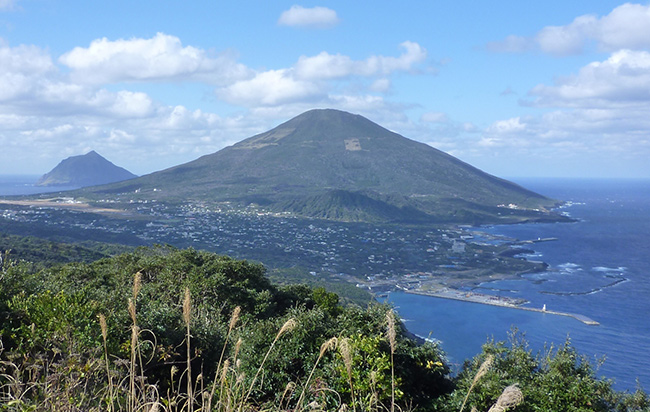 Mt. Hachijo-Fuji(Photos provided by: Tokyo Metropolitan Islands Promotion Corporation)
Mt. Hachijo-Fuji(Photos provided by: Tokyo Metropolitan Islands Promotion Corporation)
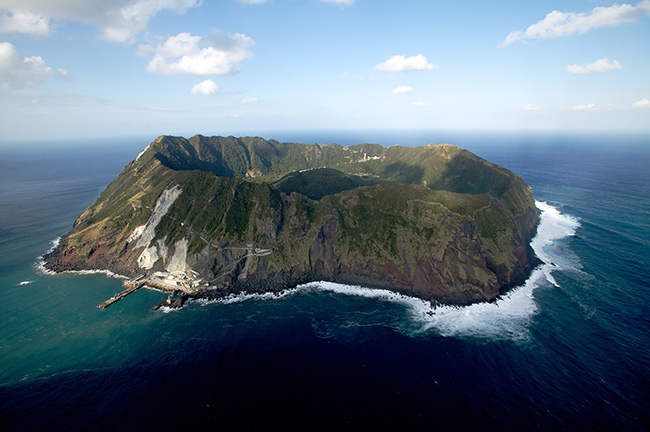 Aogashima Island(Photos provided by: Tokyo Metropolitan Islands Promotion Corporation)
Aogashima Island(Photos provided by: Tokyo Metropolitan Islands Promotion Corporation)
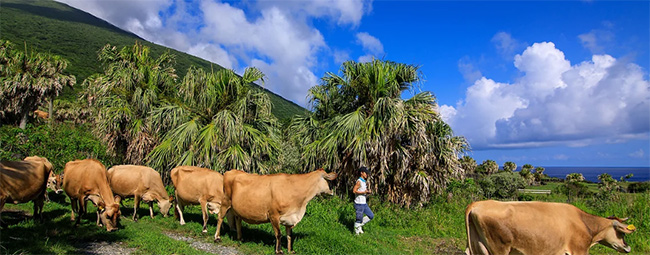 Hachijo YUYU Dairy Farm(Photo provided by: Hachijo Dairy Industry Inc.)
Hachijo YUYU Dairy Farm(Photo provided by: Hachijo Dairy Industry Inc.)
Aiming to create a minshuku where guests can fully enjoy Hachijojima Island, a gem of untouched natural beauty
When we reopened after the renovations, we had no experience in accepting international visitors—we were just running at full speed and operating at full capacity for the first year. We learned that international visitors arrive even during Japan’s low season. Even now, we feel that we have not yet fully grasped the needs of these visitors nor adequately communicated the charms of Hachijojima Island to them as island residents.
When we asked our guests the purpose of their visit to the island, we were surprised to find out that many came here to climb Mt. Hachijo-Fuji and visit Aogashima Island. Aogashima Island seems to be especially popular because it is the most secluded island in Japan. Aogashima Island is accessible by boat and helicopter from Hachijojima Island, but the helicopter flights are popular and are becoming more difficult to book. Climbing Mt. Hachijo-Fuji is a popular activity among those who enjoy walking. It is a moderate hiking trail that can be reached by car up to the fifth station. From there, the round-trip hike to the summit takes about two to three hours on foot. Both Aogashima Island and Mt. Hachijo-Fuji are free from fences and other man-made structures, allowing visitors to enjoy unspoiled nature to the fullest. One time, I saw a foreign guest lying on the ground. Concerned, I asked them what they were doing. They told me that they were taking in Hachijojima Island’s clear, starry sky. This episode reminded me that the stars in the night sky, which I had taken for granted, were one of the island’s major tourism resources.
We will continue to improve our ability to accommodate the needs of our guests by applying what we have learned from this renovation project. We are looking forward to becoming a completely barrier-free minshuku where everyone can relax and feel at ease, while at the same time communicating to the world the charms of Hachijojima Island and its pristine natural beauty.
 Mt. Hachijo-Fuji(Photos provided by: Tokyo Metropolitan Islands Promotion Corporation)
Mt. Hachijo-Fuji(Photos provided by: Tokyo Metropolitan Islands Promotion Corporation)
 Aogashima Island(Photos provided by: Tokyo Metropolitan Islands Promotion Corporation)
Aogashima Island(Photos provided by: Tokyo Metropolitan Islands Promotion Corporation)
 Hachijo YUYU Dairy Farm(Photo provided by: Hachijo Dairy Industry Inc.)
Hachijo YUYU Dairy Farm(Photo provided by: Hachijo Dairy Industry Inc.)
 social media accounts
social media accounts
Tokyo, a city that is accessible everywhere to anyone.
Sightseeing where you wish, as you wish.
This ability to travel anywhere you please makes life that much richer.
Tokyo welcomes your visit.
Here you can encounter tradition,
history, culture, nature, technology,
and, best of all, smiling faces.
Making tourism closer and more
enjoyable through accessible tourism.



